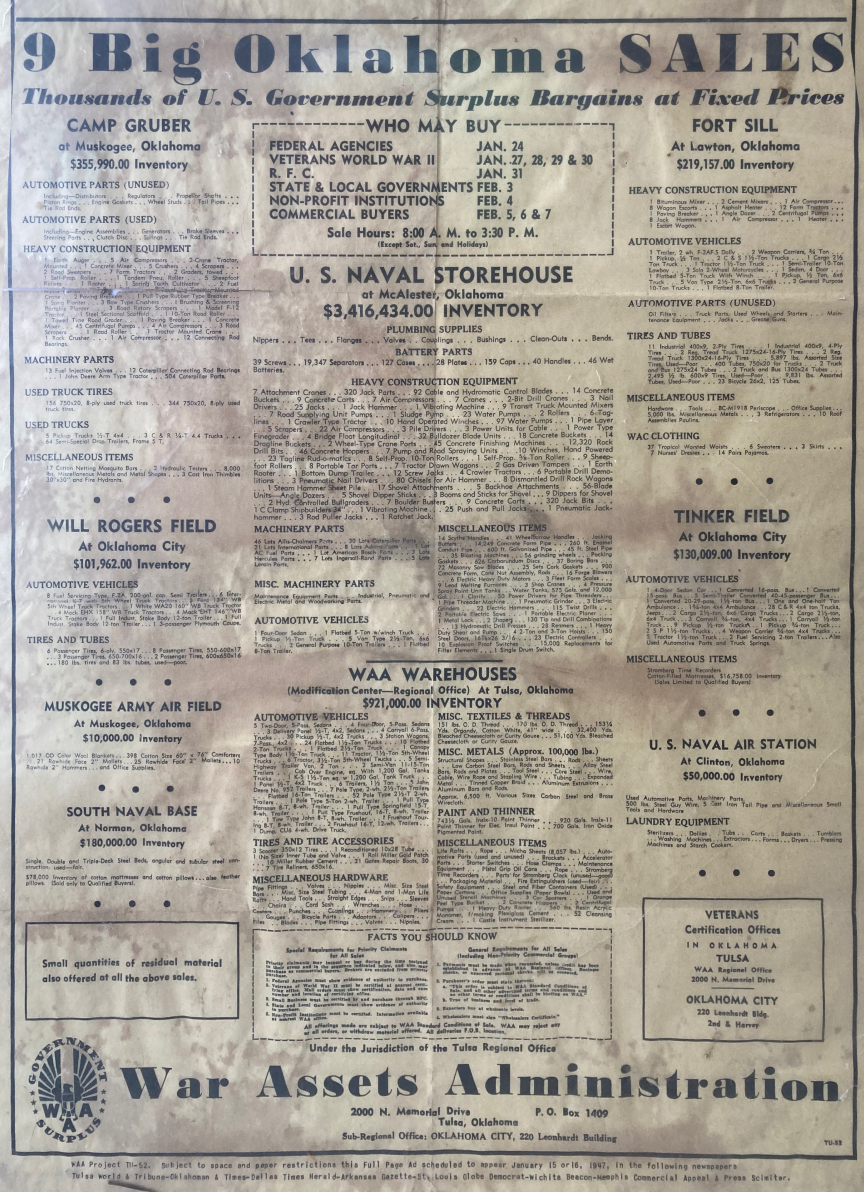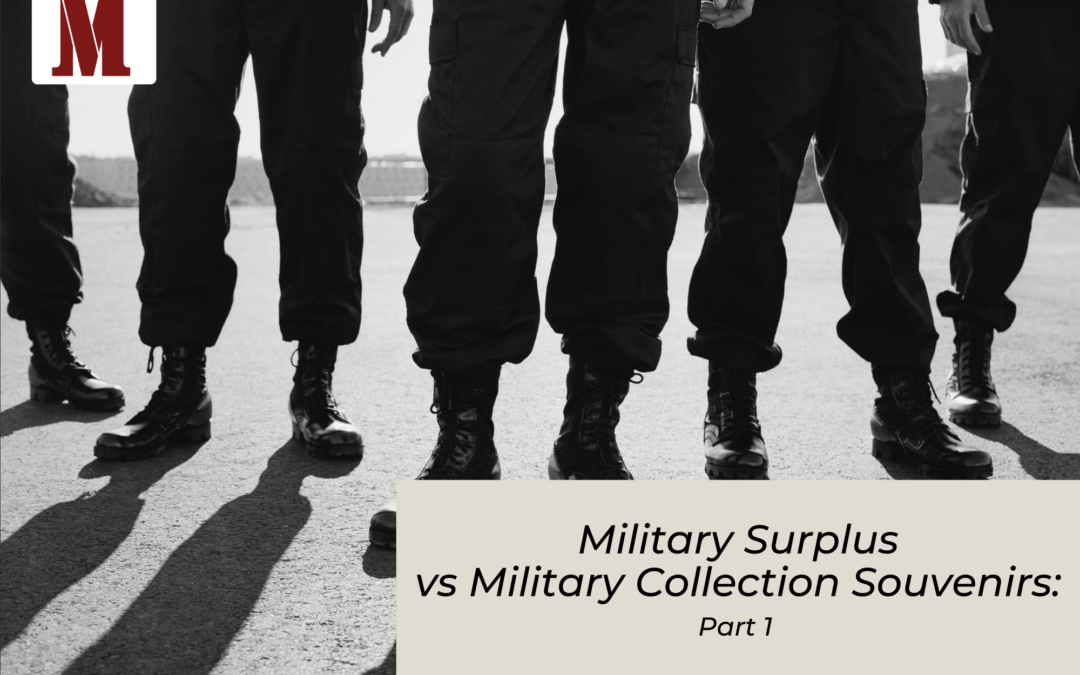This week I would like to discuss the many differences between Surplus Military Items and War Souvenirs. America is the land of military surplus. It was true after the World War I when the war ended suddenly much sooner than anyone had planned. The US was still drafting men and outfitting them as Soldiers when the war abruptly ended in November 1918. One of the second and third order effects soon became mountains of surplus uniforms and equipment. The US government had purchasing contracts with some companies, but others were paid daily or weekly on the number of items they delivered. Some firms were stuck with thousands of items that the government no longer purchased and were forced to liquidate them as quickly as possible. The government was forced to honor many contracts and it is not uncommon to see production dates of 1919, 1920 and 1921 on various canvas field equipment. Chaos is an appropriate word for this mess. A third order effect was most US WWI items were readily available for very cheap prices for decades. When I first started collecting militaria in the 1970’s WWI US items were popular with collectors because it offered a low-cost militaria collecting field.
It is difficult to compare US Government procurement activities during WWII with the WWI experience. During WWII, the government purchase everything imaginable and not only for the US military. The US supplied large amounts of military equipment to Britain, China, France and the Soviet Union under a program called Lend-Lease. WWII generated the production of tens of thousands of Tanks, Trucks and Aircraft along with millions of other lesser items. When the war ended, there was simply no use for this equipment. Much of this equipment was given away to friendly local governments or simply destroyed in the remote locations it found itself in. I found this early 1947 War Surplus Administration poster advertising surplus government property being disposed of at the various military facilities in Oklahoma. First, I had no idea there were this many military bases ands stations in Oklahoma. Reading this gives one some idea as to the magnitude and volume of the merchandise being liquidated.

The idea behind the Military Surplus Store was born. Here were seemingly unlimited amounts of low-cost, high-quality items just beckoning to be reused by the general public. Joplin had a very good store called Shanks Army Surplus Store located in the fourteen hundredth block of South Main Street. I remember as a kid buying my US helmet liner, cartridge belt, and canteen there during the early 1960’s. Many of these stores were able to stay in business for thirty years before the quantity of items were finally exhausted. During this time, America became the world’s home for military surplus items from all over the world. The three countries that best illustrate this trend were Spain, Sweden, Switzerland. Spain was the beneficiary of many countries largesse during the Spanish Civil War. The French and Russians supplied large quantities of all kinds of military hardware to the Republican side while the Italians and Germans supplied the Nationalist side. These items were sold off in the early 1960’s and were the source of many nice French, Italian and Russian helmets being brought into this country. Both the Swiss and Swedish governments sold large quantities of helmets, bayonets, rifles and just about everything else they did not need during the 1970′ and 80’s.
At the beginning of the 1970’s Unique Imports made a deal with Norway to buy their supply of WWII German Helmets. At the end of WWII, nearly 400,000 German Soldiers capitulated to the allies in Norway where they left their equipment. The Norwegian government viewed this as a windfall for their Army and began programs to reuse this military equipment. The German helmets were repainted with Norwegian decals added and the liners were dyed an oxblood color. Unique imports repainted these helmets in several different colors and supplied a reproduction set of decals that could be applied by the new owners. These helmets were sold throughout the 1970’s through ads in various military interest magazines and were the largest single source of German helmets in the US. Other companies joined the effort and marketed their items in advertisements in the Shotgun News. Other names that come to mind are Globe Militaria, Sarco, Barnicle Wharf (B & W) Trading Post, and later, Sportsmen’s Guide, and Cheaper Than Dirt all imported military items for sell to the US market.
Surplus was often collected to avoid the high cost of other militaria items. During the 1970’s, items from communist countries became popular military collectibles and their prices rose with their popularity. During this time, the Iron Curtain was a massive barrier to all kinds of trade with Communist countries. The Berlin Wall was erected in August 1961, largely to prevent highly trained East Germans from defecting to the west. For decades, the amount of Communist Military Items coming through the Iron Curtain was barely a trickle. When the Soviets invaded Afghanistan in 1979, a new market was opened. My good friend, George Petersen, traveled to Pakistan where he purchased captured Soviet uniform items in the open-air markets just over the border. At the time, a blue wool Soviet Airborne Beret and blue and white stripped Airborne undershirts each sold for over $300. Brand new Soviet General’s tall wool hats were bringing over $500. The newly issued Soviet Border Guard camouflage suits were selling for $2,500! East German items joined their Soviet counterparts in the runup of prices. The prized East German Collectible was their unique Steel Helmet that easily commanded for $500. At the time, it was easier for US Soldiers to visit East Berlin as a provision of the Four Power Agreement that divided Berlin between the four victorious Allied Powers (U.S., U.K., France and The Soviet Union) allowed Soldiers to visit the different sectors. Soon trade developed between the Soldiers. Soviet Soldiers wanted all forms of western goods (clothes, shoes, small electric radios, Playboy Magazines) and were willing to trade any military items that they could steal from the system. At one time, it was common to see Soviet Soldiers selling cans of gasoline to West German motorists. The Soldier would then give the money to his Company Commander and be sent back to sell more. This all came to an abrupt end in 1989 when the Berlin Wall fell. The East German Government fell apart in a couple of weeks and the reunification of the two countries quickly became a reality. Sturm, a West German Militaria Company, purchased the entire stocks of the East German Army and Security Forces.
As the Berlin Wall fell, prices of East German Military also fell. The mid 1980’s $500 East German Helmet fell to $20. US surplus and resale stores were flooded with every item once used by the East German Army and Police. East German visor hats and uniforms were sold for $10 each. Prices were much less if you bought in quantity. Two years later, the Soviet Union dissolved and the prices of their military items soon followed suit. The market was soon saturated and the prices continued to drop. Ukraine became the largest supplier of Soviet Communist items as they sold off seventy years of things left over by their former Soviet masters. The prices of these items have never recovered the highs of the 1980’s.
Next month I will discuss war souvenirs and how they were returned to the US so be sure to check back often! Do you have a personal collection or inherited a militaria collection from a family member but don’t know the worth of your military items? Make an appointment with Military Collector Services! With several decades of selling and buying military collectibles, our customers can feel confident they are receiving the best value for their collection or item.
